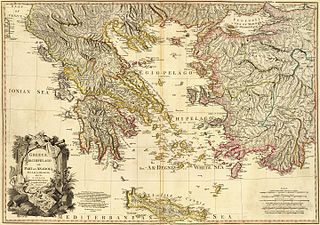 W
WArchaic Greece was the period in Greek history lasting from the eighth century BC to the second Persian invasion of Greece in 480 BC, following the Greek Dark Ages and succeeded by the Classical period. In the archaic period, Greeks settled across the Mediterranean and the Black Seas, as far as Marseille in the west and Trapezus (Trebizond) in the east; and by the end of the archaic period, they were part of a trade network that spanned the entire Mediterranean.
 W
WMany local variants of the Greek alphabet were employed in ancient Greece during the archaic and early classical periods, until they were replaced by the classical 24-letter alphabet that is the standard today, around 400 BC. All forms of the Greek alphabet were originally based on the shared inventory of the 22 symbols of the Phoenician alphabet, with the exception of the letter Samekh, whose Greek counterpart Xi (Ξ) was used only in a sub-group of Greek alphabets, and with the common addition of Upsilon (Υ) for the vowel. The local, so-called epichoric, alphabets differed in many ways: in the use of the consonant symbols Χ, Φ and Ψ; in the use of the innovative long vowel letters, in the absence or presence of Η in its original consonant function ; in the use or non-use of certain archaic letters ; and in many details of the individual shapes of each letter. The system now familiar as the standard 24-letter Greek alphabet was originally the regional variant of the Ionian cities in Asia Minor. It was officially adopted in Athens in 403 BC and in most of the rest of the Greek world by the middle of the 4th century BC.
 W
WAzoria is an archaeological site on a double-peaked hill overlooking the Gulf of Mirabello in eastern Crete in the Greek Aegean. "Azoria" is a local toponym, not apparently an ancient place name or epigraphically-attested Greek city.
 W
WThe Corinthian helmet originated in ancient Greece and took its name from the city-state of Corinth. It was a helmet made of bronze which in its later styles covered the entire head and neck, with slits for the eyes and mouth. A large curved projection protected the nape of the neck.
 W
WCroesus was the king of Lydia who, according to Herodotus, reigned for 14 years: from 560 BC until his defeat by the Persian king Cyrus the Great in 546 BC.
 W
WEteocretan is the pre-Greek language attested in a few alphabetic inscriptions of ancient Crete.
 W
WThe "Illyrian type helmet" is a style of bronze helmet, which in its later variations covered the entire head and neck, and was open-faced in all of its forms. It originated in Peloponnese, ancient Greece, and was developed during the 8th and 7th centuries BC. Accurate representations on Corinthian vases are sufficient to indicate that the "Illyrian" type helmet was developed before 600 BC. The helmet was misleadingly named as an "Illyrian" type due to many early finds coming from Illyria.
 W
WThe Lemnian language was spoken on the island of Lemnos in the second half of the 6th century BC. It is mainly attested by an inscription found on a funerary stele, termed the Lemnos stele, discovered in 1885 near Kaminia. Fragments of inscriptions on local pottery show that it was spoken there by a community. In 2009, a newly discovered inscription was reported from the site of Hephaistia, the principal ancient city of Lemnos. Lemnian is largely accepted as being closely related to Etruscan. After the Athenians conquered the island in the latter half of the 6th century BC, Lemnian was replaced by Attic Greek.
 W
WThe Nine Lyric or Melic Poets were a canonical group of ancient Greek poets esteemed by the scholars of Hellenistic Alexandria as worthy of critical study. In the Palatine Anthology it is said that they established lyric song.
 W
WTypes of Women, sometimes translated simply as Women or rendered as Semonides 7, is an Archaic Greek satirical poem written by Semonides of Amorgos in the seventh century BCE. The poem is based on the idea that Zeus created men and women differently, and that he specifically created ten types of women based on different models from the natural world. Semonides' poem was influenced by Hesiod's story of Pandora, told in both his Works and Days and his Theogony. The poem survives due to its inclusion in Joannes Stobaeus' Anthology. Despite the poem's length and its interest as evidence as to early Greek attitudes towards women, it has received little scholarly attention and has generally been considered to be of little literary merit.